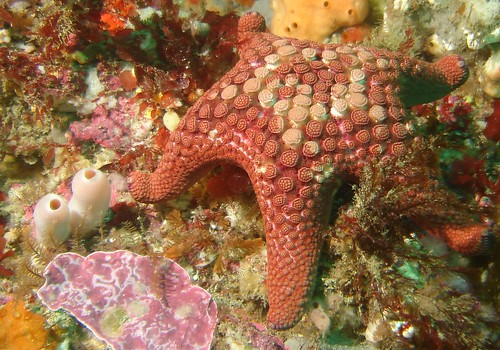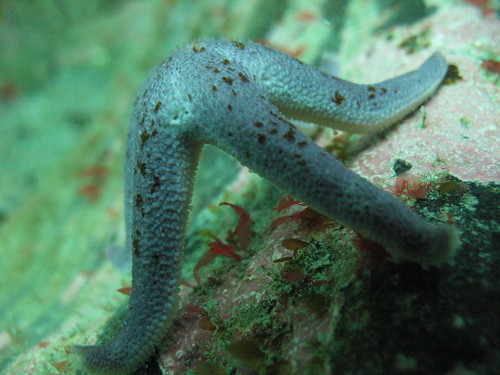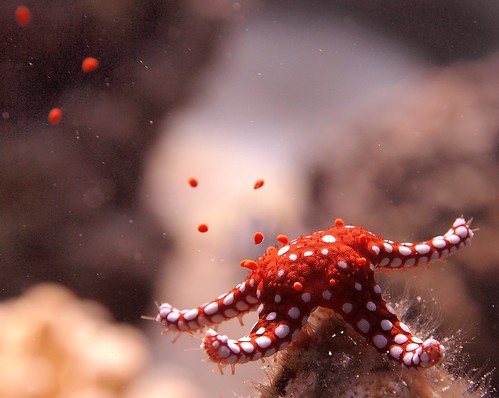How many times in my professional career have I been approached by a diver or some experienced field biologist with a picture of some animal doing an ODD thing. They bring the picture to me and say "By the way, we see this ALL the time. I'm sure its well known".
And it turns out, that it is NOT well known but it sure seems like it ought to be known! Why don't we know???
Case in point- the topic of today's blog-the "spawning posture" observed in sea stars!! This is the odd stance taken by asteroids as they climb up on their tippy toes with disk sticking upward into the water as well-demonstrated by this tropical goniasterid from Japan, Fromia indica
And sometimes they do it en masse!
While I was researching this topic I was quite surprised to learn that there haven't been ANY studies on how doing this weird "step up on the tippy toes" posture helps or otherwise affects the animal during spawning
One sees this posture in cold water species such as the North Pacific Pisaster brevispinus
and Evasterias troschelii
and just to show that its apparently not taxon specific, here is the solasterid Solaster stimpsoni
with
more pix of this species spawning here for good measure...
But the behavior is seen in MANY other temperate-cold water North Pacific species including
Pisaster ochraceus, and even the
large Pycnopodia helianthoides (kind of)!
The posture is ALSO seen in tropical species, in addition to Fromia above, we also have examples such as this cushion star, Culcita novaeguineae "standing" up on its arm tips!!
here's the oreasterid Protoreaster nodosus

and this large multi-rayed Luidia from New Caledonia. Its worth noting that this species is about 1 to 2 feet across! So, one of these standing up is uh...kind of creepy..

(From Catala's Treasures of the Tropic Seas)
AND as long as we are on the topic.. ophiuroids (i.e., brittle stars) ALSO display this behavior!
Here's some small green tropical Ophiactis doin' their thing! (best seen in the one on the left)
One might ASSUME that it provides a platform for the gametes as they are emitted, higher into the water column.
But we actually don't know! What one might infer or assume might not (and sometimes just isn't) the case.
People are always surprised when I tell them that.
Often times, you have some behavior or other biology going on-but we just haven't scratched the surface of understanding some of these familiar but surprisingly poorly known species...
And what seems "obvious" to some people becomes a question once you think about it.
For example, why do sea stars NOT always assume such a posture?? Some species, such as this Australian Acanthaster planci (Crown of Thorns) seem to just go for it without the standing on their toes action!
Interestingly there appears to be variation in behavior even within a single species for this behavior!
For example, these images of
Ochre stars (Pisaster ochraceus) and
Sunflower stars (Pycnopodia helianthoides) (click on each to see) also show some variation in posture as gametes being released. (
Note that individual gender can't really be determined without sampling the gametes as there is no sexual dimorphism, but I don't know if the individuals in these pictures were sexed.)
There are a HOST of questions that accompany something as important but as unexplained as these spawning postures!
- Does the spawning posture maximize reproductive behavior?
- Why do some species spawn "flat' versus "standing"??
- Does the posture relate to the amount of gametes produced?
- Could this behavior be related to seasonal conditions? Nutrients? Current flow?
- Does behavior vary in cold versus tropical water species??
- Do different species vary in their reproductive posture?? How many species?
So to that marine biology student without a project out there reading this in the middle of the night?? You want to travel?? You want to unravel the mysteries of the stars?? (Well,...sea stars) You want fabulous riches and fame beyond your wildest imaging?
GO DO THIS!!! (please note that riches and fame are exaggerations and are not necessarily applicable or guaranteed)
And thank me in the Acknowledgments.
So Sayeth the Echinoblog !!
UPDATE
Here are further species documented with this posture...Do you have a picture of a starfish/seastar doing this? Please let me know in the comments!
Here is Nectria sp. (Goniasteridae) from temperate water Australia. Image by Martin A. Hansen
and possibly this Uniophora granifera from temperate Australia
A Henricia (?) from Ireland. Image by David Riordan
The ophidiasterid Leiaster leachi spawning!
another update...May 17, 2013. Linckia spawning..
Here's a nice shot of Linckia laevigata spawning..from Mabini in the Philippines...
Fromia maybe F. ghardaquana from Egypt. Image by Stephen Childs
Choriaster granulatus (Oreasteridae) Image by John B. Williams
















